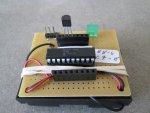As is typical for me, I've taken a project which could be created by any of the regulars here in less than 20 minutes, and turned it in to a week's worth of effort in a demonstration that anything (especially software) can be over-engineered... But I do hope the result is worthwhile and useful.
This is a really simple but very flexible way to log data using a PICAXE microcontroller. Minimal parts, flexible data samplng, great battery life, and simplicity of data export to a PC were the important design considerations. I initially hacked this together quickly to monitor the charge state of a battery hooked up to a solar panel. Then I used it to monitor the temperature change in a room from the furnace, and then looked at changes in ambient light levels due room lights and daily sunlight. I kept adding features to this project (hence the week of effort) to make it completely standalone and configurable over the serial line. It now includes battery level indication, extremely efficient power use including a low power mode, and a range of input configurations.
This logger can read a voltage, a resistance, the internal temperature sensor, an external DS18B20 temperature sensor, or even monitor its own power supply. It is entirely controlled via the same serial cable that is used to program the PICAXE. The only parts are the PICAXE circuit, an LED to indicate that the logger is functioning, and a connection to the device being monitored (unless you use the internal temp sensor).


Full project details available at http://www.corticalcafe.com/picaxe_simplest_datalogger.html
This is a really simple but very flexible way to log data using a PICAXE microcontroller. Minimal parts, flexible data samplng, great battery life, and simplicity of data export to a PC were the important design considerations. I initially hacked this together quickly to monitor the charge state of a battery hooked up to a solar panel. Then I used it to monitor the temperature change in a room from the furnace, and then looked at changes in ambient light levels due room lights and daily sunlight. I kept adding features to this project (hence the week of effort) to make it completely standalone and configurable over the serial line. It now includes battery level indication, extremely efficient power use including a low power mode, and a range of input configurations.
This logger can read a voltage, a resistance, the internal temperature sensor, an external DS18B20 temperature sensor, or even monitor its own power supply. It is entirely controlled via the same serial cable that is used to program the PICAXE. The only parts are the PICAXE circuit, an LED to indicate that the logger is functioning, and a connection to the device being monitored (unless you use the internal temp sensor).


Full project details available at http://www.corticalcafe.com/picaxe_simplest_datalogger.html
Last edited:
